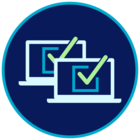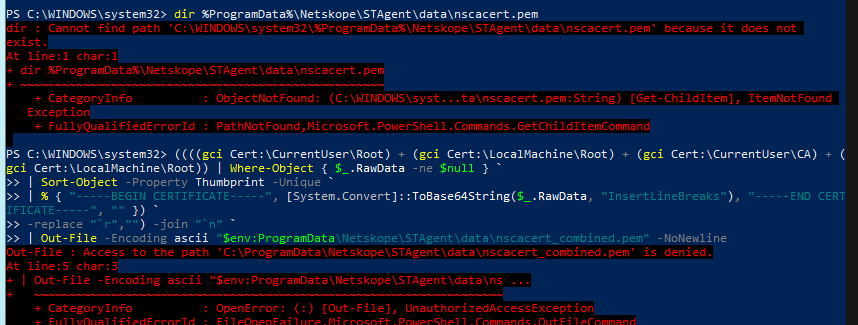(This Article is Outdated, Netskope Team is working to update this Article. Reach out to Netskope Support or your assigned TCSM for further assistance)
If Netskope is deployed inline (for CASB or Web), some CLI tools will not work because they use certificate bundles distributed with those tools (i.e. Python distribution, for example), and they do not access system certificate store where Netskope client installs Netskope root CA. The guidance below will allow you to enable those tools to seamlessly work with Netskope SSL interception.
In order for these tools to trust Netskope-signed certificates, they need to be configured to trust Netskope Certificate Authority (CA). This is typically accomplished by setting certain environment variables to point to Netskope CA to allow for smooth SSL operation.
The variables need to be set to point to the following files that contain Netskope CA:
On a Mac: /Library/Application Support/Netskope/STAgent/data/nscacert.pem
On Windows: %ProgramData%\Netskope\STAgent\data\nscacert.pem
For example to set REQUESTS_CA_BUNDLE variable on a Mac to point to the Netskope root CA, you can run this command:
export REQUESTS_CA_BUNDLE='/Library/Application Support/Netskope/STAgent/data/nscacert.pem’
Combined Certificate Bundle
Some software allows one to specify additional certificate bundles to be trusted in addition to the standard certificates, but other software requires that you override the entire trusted certificate bundle. In order to ensure that clients/browsers trust both sites that have their traffic redirected and ones that don’t have their traffic redirected, a combined certificate bundle may be required with the contents of both the standard certificate bundle and the Netskope certificate bundle.
A combined certificate bundle can be created from the operating system certificate store (which already contains both standard certificates and Netskope certificates) with the following commands:
Windows (Powershell)
((((gci Cert:\CurrentUser\Root) + (gci Cert:\LocalMachine\Root) + (gci Cert:\CurrentUser\CA) + (gci Cert:\LocalMachine\Root)) | Where-Object { $_.RawData -ne $null } ` | Sort-Object -Property Thumbprint -Unique ` | % { "-----BEGIN CERTIFICATE-----", [System.Convert]::ToBase64String($_.RawData, "InsertLineBreaks"), "-----END CERTIFICATE-----", "" }) ` -replace "`r","") -join "`n" ` | Out-File -Encoding ascii "$env:ProgramData\Netskope\STAgent\data\nscacert_combined.pem" -NoNewline
Note: The Windows (Powershell) script doesn’t work if the Protect Client configuration and resources option is enabled in the Netskope Client Configuration.
Mac
#!/bin/bash
# This script automates the process of creating a bundled certificate to be used for the requests library in Python
# and sets the correct env var to work seamlessly with Netskope.USERNAME=$(dscl . list /Users | grep -v '^_' | grep -v 'nobody' | grep -v 'daemon'| grep -v 'root')
echo "User is: $USERNAME"
# Check if the certificate file is in the right location.
if [ -f "/tmp/nscacert_combined.pem" ]
then
echo "File exists."
else
echo "File does not exist, creating."
security find-certificate -a -p /System/Library/Keychains/SystemRootCertificates.keychain /Library/Keychains/System.keychain > /tmp/nscacert_combined.pem
fi# Check if zshrc exists.
if [ -f "/Users/$USERNAME/.zshrc" ]
then
echo "Zshrc exists."
RCFILE="/Users/$USERNAME/.zshrc"
# Check if bashrc exists.
elif [ -f "/Users/$USERNAME/.bashrc" ]
then
echo "Bashrc exists."
RCFILE="/Users/$USERNAME/.bashrc"
else
echo "Bashrc nor zshrc does not exist."
fi
echo "RC file is: $RCFILE"# Check if var is set in RC file.
if grep -q "export REQUESTS_CA_BUNDLE='/tmp/nscacert_combined.pem'" $RCFILE
then
echo "Environment Variable is set."
else
echo "Environment Variable not set, setting."
echo "export REQUESTS_CA_BUNDLE='/tmp/nscacert_combined.pem'"
>> $RCFILE
fi
The location of the generated certificate bundle file is as follows:
Windows
C:\ProgramData\Netskope\STAgent\data\nscacert_combined.pem ("$env:ProgramData\Netskope\STAgent\data\nscacert_combined.pem" or %ProgramData%\Netskope\STAgent\data\nscacert_combined.pem)
Mac Tools/Framework
/Library/Application Support/Netskope/STAgent/data/nscacert_combined.pem
Note:
Instead of placing the file in the /Library/Application Support/Netskope/STAgent/data folder, store it in a persistent location such as /tmp, or any other stable directory. Then, export the REQUESTS_CA_BUNDLE environment variable to point to the new location of the .pem file. This approach avoids deletion and ensures proper functionality.
Below is the list of tools/frameworks and instructions on how to make them compatible with Netskope SSL interception:
| Tools/Framework | Instructions |
|---|---|
| Android Studio | https://support.netskope.com/s/article/Android-Studio-certificate-warning-Server-s-certificate-is-not-trusted |
| AWS CLI | Follow instructions in this article: Addressing SSL Error while Accessing AWS Services via the AWS CLI with the Netskope Client Enabled |
| Azure CLI | Azure CLI is Python-based, and it requires that the Netskope certificate bundle be available along with the default certs. We can either add the Netskope cert bundle to the default cert bundle located at C:\Program Files (x86)\Microsoft SDKs\Azure\CLI2\Lib\site-packages\certifi\cacert.pem on Windows and /opt/az/lib/python3.6/site-packages/certifi/cacert.pem on Linux, or we can create another file that has all the certificates and point the REQUESTS_CA_BUNDLE variable to this file. Details about this can be found here: https://docs.microsoft.com/en-us/cli/azure/use-cli-effectively#work-behind-a-proxy |
| Boto | Boto is a Python library, but it uses AWS CLI config and environmental variables, so please use the same setup as AWS CLI in order to get Boto to work with Netskope |
| curl | If you’re using the curl command line tool, you can specify your own CA cert path by setting the environment variable CURL_CA_BUNDLE to the path of your choice. If you’re using the curl command line tool on Windows, curl will search for a CA cert file named
Get a better/different/newer CA cert bundle! One option is to extract the one a recent Firefox browser uses by running ‘make ca-bundle’ in the curl build tree root, or possibly download a version that was generated this way for you: CA Extract |
| Fastlane | Uses OpenSSL, so see OpenSSL instructions |
| Git | Git CLI can be configured to use a custom CA bundle as per instructions here: https://git-scm.com/docs/git-config#git-config-httpsslCert . Typically, the location of the CA bundle can be written into git config file or used as an environment variable GIT_SSL_CAPATH. Please note that git is a toolset that is compatible with variety of SCMs (GitHub, GitLab, Azure DevOps, etc). |
| Google Cloud SDK (gcloud CLI) | Google Cloud SDK/CLI can use custom CA bundle by using gcloud config file. Instructions on how to configure gcloud to use custom CA bundle are here: https://cloud.google.com/sdk/gcloud/reference/config/set. Windows MacOS |
| Java | https://support.netskope.com/s/article/JAVA-and-Eclipse-Unable-to-find-valid-certification-path-error |
| Node.JS | Node.js 7.3.0 (and the LTS versions 6.10.0 and 4.8.0) added NODE_EXTRA_CA_CERTS environment variable for you to pass the CA certificate file. It will be safer than disabling certificate verification using NODE_TLS_REJECT_UNAUTHORIZED. $ export NODE_EXTRA_CA_CERTS=[your CA certificate file path] The cafile configuration property works similarly: npm config set cafile [your CA certificate file path] The main difference between NODE_EXTRA_CA_CERTS and the cafile config property is that the former adds a cert, whereas the cafile config property replaces the certs. For those that just want to add a corporate cert to the chain, NODE_EXTRA_CA_CERTS is the easier option |
| OpenSSL | Netskope CA bundle needs to be added to the OpenSSL CA bundle. This depends on your endpoint. On a Mac, for example, OpenSSL CA bundle in the /usr/local/etc/openssl/cert.pem netskope-mac-ca-bundle script from GitHub automatically checks for presence of that file and adds Netskope CA cert to it if detected. Otherwise, please find cert.pem for your OpenSSL installation and add Netskope CA certificates there manually. |
| Python-based apps and scripts | Python-based tools that uses requests library can leverage CA bundle referenced by the system variable REQUESTS_CA_BUNDLE . Create your CA bundle that includes Netskope root CA for your tenant and set environment variable REQUESTS_CA_BUNDLE to point to that file |
| Salesforce Apex Dataloader | https://support.netskope.com/s/article/Salesforce-Apex-Dataloader-app-fails-to-connect-with-error-Failed-to-send-request- |
| Composer (Dependency manager for PHP) | The cafile configuration property allows for specifying a .pem file for SSL verification. This can be configured as follows: composer config –global cafile ‘<location of cafile>’ For Windows:composer config –global cafile “%ProgramData%\Netskope\STAgent\data\nscacert.pem” For MacOS:composer config –global cafile “/Library/Application Support/Netskope/STAgent/data/nscacert.pem” |










